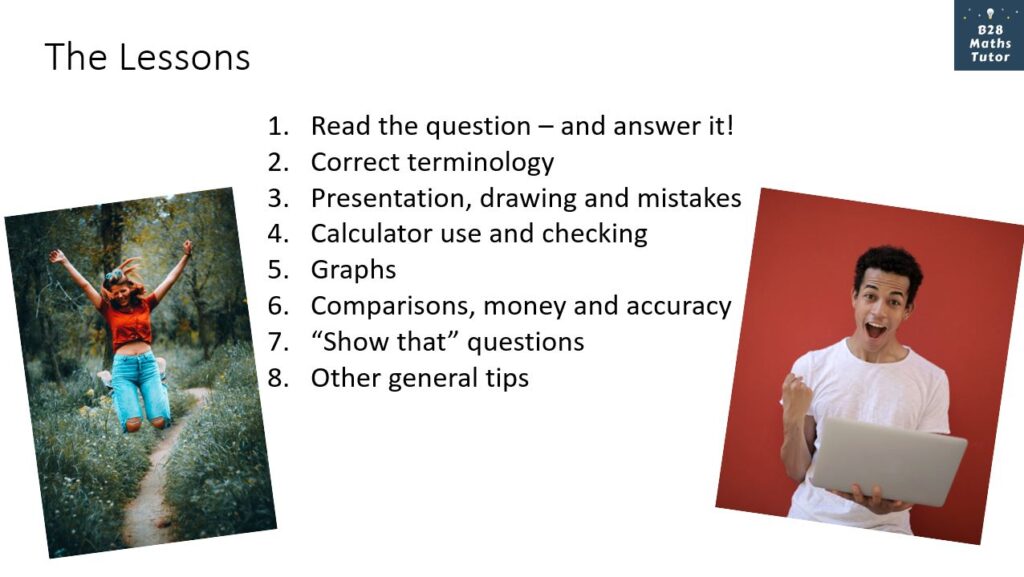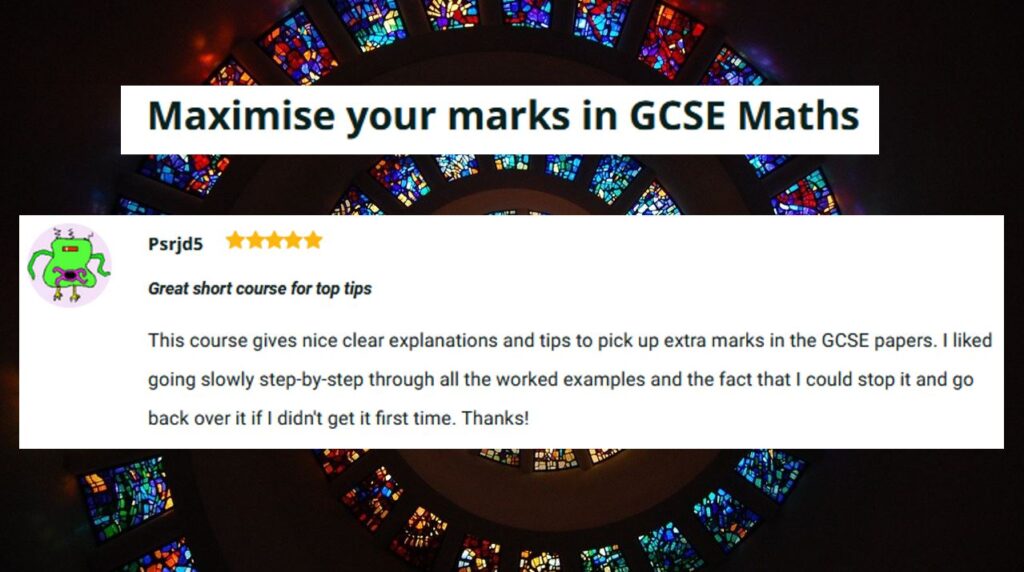Exam skills for GCSE Maths: maximise your marks
Your exam skills can make a huge difference to your mark in GCSE Maths.
Believe it or not, the examiner marking your Maths exam (or any other exam) wants to give you as many marks as possible! They want to reward you for what you CAN do, not penalise you for what you can’t, and they can only GIVE marks, not take them away.
I’ve been marking GCSE and A-level Maths exams for one of the big exam boards for a good few years, so I know that this is true.
And I’d like to help you to improve your exam skills so that you get the best possible mark in your GCSE Maths.
What are exam skills?
Good exam skills means knowing how to present your work to meet the criteria that will allow the examiner to award you as many marks as possible. The main principles to bear in mind are:
- follow instructions
- express yourself clearly
- check your work to avoid careless mistakes.
This article focuses on exam skills for GCSE Maths, but much of it is also relevant to exams at other levels and in other subjects. It’s a summary of the content of my short “Maximise your Marks in GCSE Maths” course, which contains 27 tips on how to improve your exam skills and avoid throwing marks away unnecessarily, complete with examples taken from Foundation GCSE Maths papers. If you find this article helpful then you might want to consider signing up to the full course.

So here we go…
1. Read the question – and answer it!
Read the question properly before you start to answer it, and when you think you’ve finished answering it, check again to make sure you’ve done what it asked for. For example:
- Did you need to give a conclusion, such as “Option A is better value”?
- Are the units included?
Don’t be afraid to use words to explain your thinking; remember that the examiner can’t read your mind and you want to make it easy for them to follow your reasoning.
2. Correct terminology
Make sure you understand and can use the relevant vocabulary, for example:
- factor and multiple
- product and sum
- similar and congruent
- the proper terminology for the rules involving angles (corresponding, alternate, etc.)
- the correct vocabulary for different types of transformation (translation, reflection, rotation, enlargement).
3. Presentation, drawing and mistakes
Write clearly and big enough to read easily!
Keep within the margins, use a black pen and don’t use highlighter on your answers – papers are scanned in, usually in black and white, and you want the examiner to be able to read your work easily.
For diagrams and graphs, use an HB pencil and make sure you have an eraser.
To correct a mistake, cross (or rub) it out and then rewrite it correctly. Don’t try to correct something by writing over the top of it.
As a taster of the full course, here’s the video lesson for this section.
4. Calculator use and checking
Always double-check your arithmetic, and try to sense-check the answers you get from your calculator too! For example 4.7 × 0.52 is roughly 5 × 0.5, or half of 5, so you’d expect the answer to be around 2.5; if you’re getting 24.44 then there must be something wrong, such as a wrong/missing digit or misplaced decimal point.
Also make sure that you’re familiar with the things your calculator can do to make your life easier, such as converting between hours/minutes/seconds and time in decimal form, and the TABLE function for plotting points on a graph.
I have a series of short videos on my Facebook page demonstrating some of the clever things your calculator can do. I’m intending to develop a more comprehensive course for this, which you’ll find on my Mathscourses site when it’s done.
5. Graphs
Always use pencil, not pen, for plotting points and drawing curves. Plot points accurately, and using crosses, not blobs.
Check that you know what the scales are on both axes – what does one small square represent in each case?
Practise drawing lines of best fit (Bury Maths Tutor has a nice resource here to help you get the hang of where the LOBF should go) and drawing smooth curves that pass through all the plotted points.
6. Comparisons, money and accuracy
Consider splitting the page vertically into two halves if you’re doing calculations to compare two options, and remember to state your conclusion.
Amounts of money must always be given as whole units or with two decimal places (usually pence or cents). Include the units but don’t use both p and £ together!
Use extra digits in your working but give your final answer to a sensible degree of accuracy – usually the same as in the question.
7. “Show that” questions
If the question asks you to show, prove or verify something, always finish with a statement echoing what the question said.
You must EXPLAIN what you’re doing. Just giving an answer without showing how you get there won’t get you any marks.
If a question says “Show that [complicated expression A] = [simpler expression B]” then you need to start off with A and rearrange it to find your own way to B.
Do NOT start off by stating that A = B!
8. Other general tips
- Think about timings: 1 mark per minute is generally a good pace to aim for.
- You don’t have to do the questions in order – start with the easy ones!
- If there are multiple choice questions (as on some AQA papers) then don’t leave them blank; always choose an answer, even if you’re only guessing.
- If you can’t see how to get to the answer then just think about what you CAN do with the information given. It’s often easy to get the first mark, and it might get the ball rolling for the rest of the solution.

If you’ve found this article helpful then please take a look at the full course, which goes into considerably more depth and includes a few more tips not covered here.
Of course, I emphasise these points as part of my 1-to-1 tuition as well; you can find our more about that here.
For more tips to help you achieve well in your GCSE Maths, take a look at the revision advice in this blog post.
And if you’ve found this post helpful then please share it!


One Comment